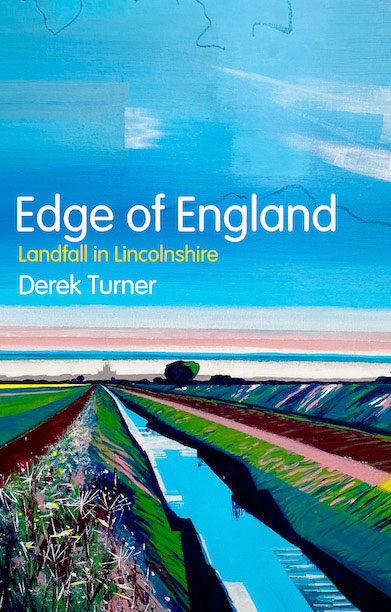
Edge of England, Derek Turner (Hurst and company, London, 2022, 446pp)
The dust jacket of this book gives a pretty good idea of the hybrid text within: a conventional fen view, all stratified horizontals, rendered in psychedelic, matt colours. This is a book with one foot in the old Robert Hale topographical guide camp and the other in amongst newer, psychogeographical readings of the landscape. Turner’s range is wide – he is as unafraid to quote Geoffrey Hill as Geoffrey of Monmouth – and it stretches historically from Anglo-Saxon events to more recent occurrences such as the Spalding Tulip Hall gig of 1967 (which featured Hendrix and Pink Floyd), the latter now as near-mythical as the former. The poet Roy Fisher used to give as one of the reasons why he wrote about Birmingham that it had never really been seen, and this could also apply to this book, subtitled as it is ‘Landfall in Lincolnshire’.
To the outsider, Lincolnshire appears fenny and an agri-prairie in places; the little market-towns do not automatically welcome you; the locals can appear grudging and suspicious. Generalisations about the place can be dangerous and misleading, however, and as he meanders around the county, Turner provides plenty of evidence of the malcontents, the iconoclasts and the eccentrics that have called it home over the centuries. In particular, there is plenty here about the historical confrontations between church and state, in the person of the monarch, and also various branches of clerical enthusiasts. Lincolnshire towns such as Crowland and the county town itself have often harboured religious zealots and mystics, and Turner carefully uncovers their stories and examines the still surviving physical traces of their rantings, uprisings and confrontations. Some of his best writing is on the more unloved corners of Lincolnshire: Grimsby and the towns clinging to the banks of the Humber allow for more detailed, careful introspection. At times, Turner’s prose can descend into alphabetical lists – an annoying stylistic tic – but he makes a genuinely curious guide and his personal experiences often feed into entertaining tales of hunting, shooting and antique-sniffing in dusty corners.
In his travels, Turner rounds up many of the local artists and writers who have lived in, originated from, or explored Lincolnshire: you’d expect to encounter Tennyson, John Clare and Betjeman, but other figures such as Paul Verlaine, John Wesley and Henry Newbolt are more surprising inhabitants. Turner is not credulous in exploring some of their lives and reputations: Wesley is revealed as a harsher figure than you’d expect, and George Borrow, author of Romany Rye, is painted as a literary fabulist, rather than a reliable chronicler of the travelling life. As for the establishment figures, Lincolnshire is particularly rich in Tory eccentrics, unreliable saints and virulent, raving parsons. Here are mystics biting and stealing relics, the fanatical composer John Taverner burning crucifixes and genuine one-offs such as George Boole, the driven Victorian mathematician who propounded Boolean logic, the system underlying all computer programmes. Clearly, there is something about the fens and the wolds that regularly brings forth such characters.
Manic, driven, stubborn – such adjectives fit many of the individuals whose lives are seen against the backdrop of this wind-blown, underpopulated place. And, so, inevitably, one comes to Grantham and Thatcher. Feelings still run high about the grocer’s daughter, as illustrated by the popular egging of the recently erected statue of her in her home town. Mercifully, Turner only devotes one paragraph to her, generously describing her as ‘a complicated as well as a divisive person’. He has, by the time he arrives in Grantham, given plenty of examples of other complicated individuals, motivated by strange, obscure beliefs and doctrines, most of whom added to the vivid tapestry of the drained fields and ruined churches. Finishing his odyssey in Stamford, Turner fittingly finds a town like the Georgian movie-set it so often becomes. Rather than denying this, or seeking to re-invent itself, however, the place has become an in-demand location for lavish Austen film adaptations and other BBC costume dramas, a shrewd and profitable move, driving up tourism. It may be looking backwards, but it is doing it on its own terms.
Turner concludes that Lincolnshire is ‘the England the rest of England half-forgot…a place that escaped.’ As someone who lived at the southern tip of it for over twenty-five years, I would agree that its distinctive character is becoming more and more eroded, but would perhaps shy at the plangent, soft-focus lyricism of his phrase. The place is not preserved in aspic, but continuing to change: one obvious omission is a discussion of the effects of some of the recent trends – the undercurrents of poverty (alongside evident wealth) in some of the towns, for example, or the influx of an Eastern European working-class culture in old ports like Boston. These are important recent developments with far-reaching social implications, and one might have expected a nod towards them, however awkward it might have been to patch them in. Despite this caveat, this fairly exhaustive tome is full of fascinating passing anecdotage and does bring an idiosyncratic, overlooked area alive. You won’t easily persuade the tight-lipped locals to explain Lincolnshire to you: luckily, Turner can.
M.C.Caseley
